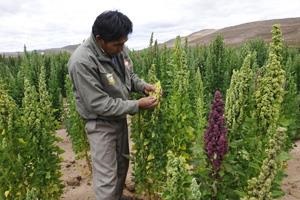
8 August 2012, Rome - Immediate action to promote sustainable diets and food biodiversity so as to improve the health of humans and of the planet is urged in a book just published by FAO and Bioversity International.
“Regardless of the many successes of agriculture in the last three decades, it is clear that food systems, and diets, are not sustainable,” says Barbara Burlingame, Principal Officer of FAO’s Nutrition and Consumer Protection Division, in a preface to the book, Sustainable Diets and Biodiversity.
“While over 900 million people in the world suffer from hunger, even more – about 1.5 billion – are overweight or obese, and an estimated two billion suffer from micronutrient malnutrition including vitamin A, iron, or iodine deficiency,” Burlingame notes.
The problem of feeding the world’s growing population has so far been seen largely in terms of providing sufficient quantities of food, the book points out. But the pace of biodiversity loss and ecosystem degradation, coupled with emerging health issues related to diet, make it urgent to address the quality of agriculture and food systems. Poor diets are linked to marked increases in non-communicable diseases such as diabetes and cardio-vascular diseases across the world.
Heavy footprints
High-input industrial agriculture and long-distance transport have made refined carbohydrates and fats affordable and available across the globe, leading to an overall simplification of diets and reliance on a limited number of energy-rich foods. But such foods lack nutrient quality and have heavy carbon and water footprints. Cheap, energy-dense foods have also come at the cost of flavour, diversity and cultural connection.
Currently just three major staples crops – corn, wheat and rice – provide 60 percent of the dietary energy from plant origin at global level, while, with rising incomes in developing economies, huge numbers of people are abandoning traditional plant-based foods in favour of diets rich in meat, dairy products, fats and sugar.
The book argues that modern diets and food production methods play a significant role in shrinking plant and animal genetic diversity, with 17,291 species out of 47,677 assessed by the International Union for the Conservation of Nature described as threatened with extinction.
Urgent need
“There is an urgent need to change the paradigm of agricultural production in order to integrate the dimension of nutritional quality in our decisions as to what to produce and where,” writes Emile Frison, Director General of Rome-based Bioversity International.
“This requires us to move beyond the major staples and to look at the many hundreds and thousands of Neglected and Underutilized plant and animal species that mean the difference between an unsustainable and a sustainable diet.”
In Kenya, for instance, Bioversity have successfully helped reinstate a number of leafy green vegetables until recently considered as poor people’s food into local diets and markets. Promotion of the traditional plants, including African night shade, cowpea and pumpkin leaves, spider plant and vine spinach, has increased demand both within households and in the market. Smallholder farmers are also benefiting.
In India, healthy cereals such as foxtail and finger millet have been reintroduced in areas where they had been abandoned due to government policies promoting cassava production for starch. Efforts are also underway to promote native Andean cereals such as quinoa and amaranth at the international level. The United Nations has declared 2013 to be the International Year of Quinoa.
Major effort
“The transition of diets based on energy-dense foods high in fat and sugar is not inevitable,” writes Frison. “We must make a major effort to ensure that all people in the world will not only have adequate food but adequate nutrition to meet their needs”.
Our food systems need to undergo ‘radical transformations’ towards a more efficient use of resources and more efficiency and equity in the consumption of food and towards sustainable diets, Burlingame says.
“Sustainable diets can address the consumption of foods with lower water and carbon footprints, promote the use of food biodiversity, including traditional and local foods, with their many nutritionally rich species and varieties,” she adds. “They can also contribute to the transition to nutrition-sensitive and climate-smart agriculture and nutrition-driven food systems.”